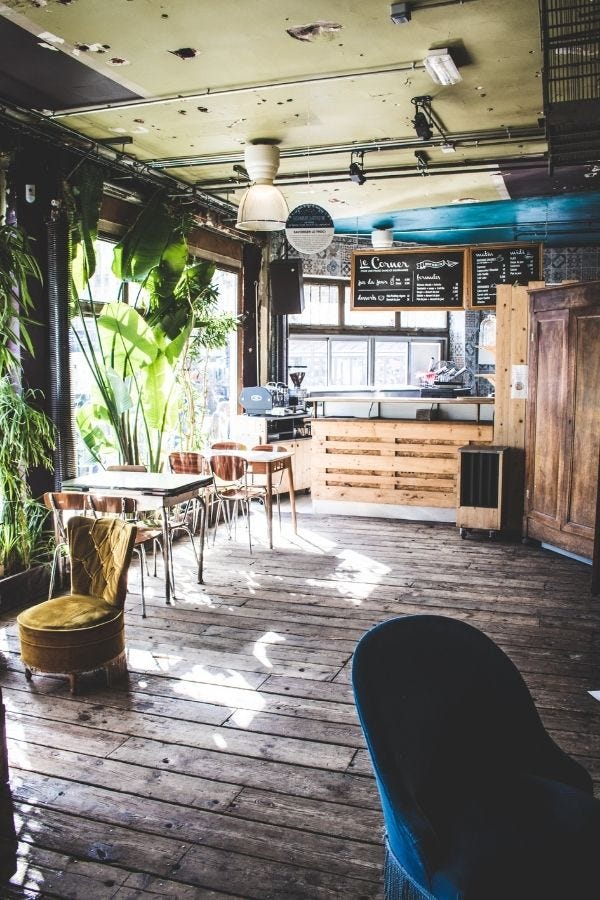Newsletter #5
“Hope is not the conviction that something will turn out well,” Vaclav Havel, the Czech dissident, writer, and statesman, said, “but the certainty that it is worth doing no matter how it turns out.”
Post #1 Food Story
- the benefits of eating produce grown locally & in season -
When eating locally grown seasonal produce, I do feel that I’m getting the exact nutrients that I need at the exact time I need them. For example, what grows in the summer where you live is exactly what your body needs, and the same principle applies to other times of the year. It’s a cold snowy winter where I live, and the produce available at the local farm markets are mostly root vegetables, cruciferous and bitter greens and sprouts, which are all bursting with Vitamin A.
Vitamin A helps maintain mucous linings in the nose (where germs are caught as they try to enter the body); strengthens the immune system (warding off infection) and improves vision in dim light. The greens you are eating are your own anti-flu and cold prescription.
-Radicchio Tardivo, Castelfranco and Pink Radicchio-
photo by Priscilla Woolworth
When I lived in Los Angeles, by September the large fig tree in my garden would be dripping with delicious Black Mission figs. I found out that figs have the highest mineral content of any fruit, and mineral loss during heat waves can be catastrophic (September is one of the hotter months in SoCal).
Another reason to eat locally grown food, according to the Harvard Medical School Center for Health and the Global Environment, is that food transported long distances is not likely to be as nutritious as food grown and consumed locally.
Additionally, the Center for Health and the Global Environment recommends choosing produce that is as fresh as possible. If you can't grow your own, look for local farms or growers. The center also notes that buying locally increases the chances of nutritional diversity and decreases the amount of handling, since local produce is commonly picked by hand rather than machine. Minimal handling means less chance of contamination, which can increase the rate of decay.
Eating food out of season — such as consuming winter vegetables in the summer — makes little sense economically, environmentally or nutritionally. Eating seasonally helps the economy, the environment and your health.
To find out what is in season in your area:
To find your local CSA (community supported agriculture)
Oven Roasted Cauliflower
~featured in Food and Wine~
This delicious recipe is easy to make. All you need is one fresh cauliflower with tight, closed florets surrounded by a crown of crisp leaves; coarse Himalayan salt, which packs a mineral flavor in bits of crunchy saltiness; and spicy, fruity extra-virgin olive oil.
Did you know that cauliflower is high in vitamins c and k, beta-carotene, is an anti-inflammatory, and is high in antioxidants, supporting healthy digestion and detoxification. Eating cauliflower is good for your health!
Ingredients:
1 (1 ½-to 2-pound) organically grown head cauliflower with leaves
2 gallons water
7 Tsp. Himalayan salt
3 Tbs. best-quality organic extra-virgin olive oil, divided
Directions:
Step 1
Preheat oven to 550 F with oven rack in center of oven. Trim stem of cauliflower, keeping leaves intact, so it will sit level on a rimmed baking sheet.
Bring 2 gallons water to a boil in a large stockpot over high. Stir in 6 ½ Tsp. Himalayan salt.
Step 2
Add cauliflower to water; place a heatproof ceramic plate on top of cauliflower to keep it submerged. Boil until tender and a fork inserted in cauliflower meets no resistance, 12 to 13 minutes. Using a spider (a large mesh spoon), gently lift cauliflower from water, and let drain in spider, allowing water to drip back into pot. Place cauliflower, stem side down, on a rimmed baking sheet. Let it stand until cauliflower has cooled slightly and is dry to the touch, about 15 minutes.
Step 3
Rub 1 Tbs. olive oil between hands, then rub over cauliflower to apply a thin, even layer. Alternatively use a brush to spread oil evenly over cauliflower. Sprinkle remaining 1/2 tsp. salt over cauliflower. Bake in preheated oven until dark brown, about 25 minutes. Remove from oven, and carefully rub with remaining 2 Tbs.olive oil. Serve hot.
Post #2 The Wild Fig Tree Hunters
-finding, preserving and sharing lost varieties-
It’s very exciting that in California, specimen hunters are tracking down rare new varieties of the ancient fruit. Fig cultivation in California began a slow overall decline in the late 1930s, continuing into the 1990s and early 2000s, where only a few American farmers were growing figs. As commercial fig harvests were decreasing in California, birds, wild pigs and other animals kept spreading fig seeds.
Like the tree sprouting from the center of an abandoned grain silo, these hardy plants have since rooted themselves in all kinds of bizarre spots: in drainage ditches, behind strip malls, on the edges of long-abandoned farms. Established varieties of figs, such as Black Missions and White Adriatics, are propagated through cuttings: identical clones of one another that all look and taste exactly the same. But every fig grown from a seed is a combination of its parents and could constitute its own new variety, depending on how unusual it is. Such seed dispersal has created a genetic melting pot that could bring forth new varieties with unique flavors and traits.
Even as the sprawling commercial fig orchards of America’s past disappear, thousands of smaller nurseries and hobbyist farms have popped up, planting a great diversity of figs. This trend is fueled in part by the farm-to-table and eat-local and back-to-heirloom-variety food movements, to be sure, but there is no ignoring the importance of the fig tree’s unusual hardiness and versatility. An established fig tree can survive with minimal rain and no irrigation, and it’s the plant’s toughness that makes it so thrilling to hunt.
Via Smithsonian
To buy wild fig trees
Post #3 Be Proactive!
-Climate Action Now-
With our vote, we elect the local representatives that care about the same issues as we do. Our involvement doesn’t have to end there, as those same representatives need to hear from us. Getting in touch as often as possible, and letting them know where you stand on current issues is vital to which direction they end up taking.
There is a very helpful resource that I use. It’s a time saving app called Climate Action Now, and it’s made it so much easier to take impactful climate actions by getting in touch with your state representatives.
Through the app, you can contact your elected officials or email CEOs regarding an issue you are concerned about in your state, whether it’s stopping the leasing of state forests for gas exploration, or telling your state reps to support the Dark Skies Protection Act, and also to support voting rights in your state (these were the ones I took action on today).
Find out who your elected officials are, by giving the app your location, and it will tell you. Don’t know how to contact them? The app has their phone numbers and Twitter handles. Don’t know what to tell them? The app gives you personalized, boilerplate messages that you can accept or modify.
Did you know that just 100 companies, and the politicians, investors, and regulators who enable them, are responsible for over 70% of the world’s emissions? Climate Action Now makes it easy for you to influence them with phone calls, emails, and petitions.
Did you know that the fossil fuel industry is poisoning communities of color in their own backyards? Climate Action Now helps you fight these injustices and demand an equitable future for all.
photo by Priscilla Woolworth
Post #4 La Recyclerie
-An inspiring community space-
Located in a disused train station in Paris, La REcyclerie prides itself on an eco-friendly ethos of upcycling and reuse.
La REcyclerie , open since June 2014, has devoted itself to those three famous R’s: reduce, reuse, and recycle. The site offers locally produced food and products that encourage customers to take part in environmentally sound practices in their own life.
- Jars for recycling batteries and lightbulbs -
Bring a household item that needs repairing, and have lunch in the café. In addition to its culinary roots, the center, which boasts eight separate spaces in the fully repurposed train station they call home, also offers classes that teach DIY and creative skills ranging from theater to gardening to cooking. The site also plays host to such community building events as seed swaps, readings, maker fairs and concerts.
-Repair station -
Watch a video taken at La REcyclerie:
La REcyclerie- 83 Boulevard Ornano, Paris 75018, France
www.larecyclerie.com and via Atlas Obscura and A Hedgehog in the Kitchen
Post #5 Uplifting Vibes
If an uplifting book is exactly what you need at the moment, here is a great selection of Reading Well’s mood-boosting books, a national promotion of uplifting titles, including novels, poetry and non-fiction. The books are all recommended by readers and reading groups.
Here is one of my favorites from their recommended list:
Post #6 A capella
Leaving you with this lovely video of Rufous Nightjar live at Killruddery House, featuring folk singers Branwen Kavanagh, Anna Mieke Bishop and Zoe Basha.
Coming up in the next Newsletter: directions on how to make your own Mason Bee House using materials you might just find at home. Mason Bees are huge pollinators and a very beneficial addition to your garden. This post will be available to paid subscribers!
Please share my newsletter with your loved ones! Thank you!
From the quiet, snowy and ever beautiful Hudson Valley, I send you my very warmest wishes,
Priscilla














Thank you...wonderful read. Wild Fig article so interesting love the silo image.